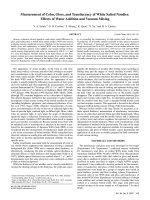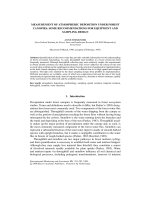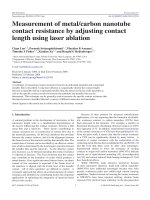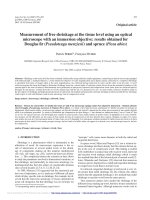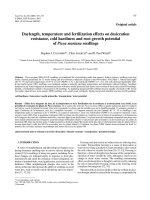experiments reports measurement of resistance capacitance inductance and resonant frequencies of rlc using oscilloscope
Bạn đang xem bản rút gọn của tài liệu. Xem và tải ngay bản đầy đủ của tài liệu tại đây (959.26 KB, 31 trang )
<span class="text_page_counter">Trang 1</span><div class="page_container" data-page="1">
Name : Student ID: Group : 6
Experiment Class: 736052
Experimental Report 1
</div><span class="text_page_counter">Trang 2</span><div class="page_container" data-page="2">MEASUREMENT OF RESISTANCE, CAPACITANCE, INDUCTANCE ANDRESONANT FREQUENCIES OF RLC USING OSCILLOSCOPE
LC circuit:
● Consists of a inductor L and capacitor C.
● Energy of circuit is transferred by charging capacitor.●
q<small>0</small>=C .U<small>0</small>2q<small>0</small>
</div><span class="text_page_counter">Trang 3</span><div class="page_container" data-page="3">4. Determination of Resonant Frequency:
We have:
¿>R<sub>x</sub>=<sup>R</sup><small>x1</small>+R<sub>x2</sub>+R<sub>x3</sub>3 <sup>=( )</sup><sup>Ω</sup>∆ R ≈<small>x</small>
√(
R R<sub>x</sub>− <sub>x 1</sub>)
<small>2</small></div><span class="text_page_counter">Trang 4</span><div class="page_container" data-page="4">⇨
<sup>C</sup><small>x 1</small>=( F)⇨
<sup>C</sup><small>x 2</small>=( F)⇨
<sup>C</sup><small>x 3</small>=( F)C<sub>x</sub>=<sup>C</sup><small>x 1</small>+C<sub>x2</sub>+C<sub>x 3</sub>a, Series RLC circuit:
f<small>x</small>=<sup>f</sup><sup>x 1</sup><sup>+f</sup><sup>x</sup><small>2</small>+f<small>x3</small>
3 <sup>=(Hz)</sup>
</div><span class="text_page_counter">Trang 5</span><div class="page_container" data-page="5">c, Predicted value using theoretical equation: Equation:
f = <sup>1</sup>2 π
√
LC2 π
√
LC=
<sub>2 π</sub>√
39.29 10× <sup>1</sup><small>−3</small>× 6.53 ×10<small>−7</small>=( Hz)∆ f =<sup>1</sup>2 π
×
f√
(<sup>−1</sup>2 <sup>×</sup>∆ L
+(<sup>−1</sup>2 <sup>×</sup>
∆ CC <sup>)</sup>
=
<sub>2 π</sub><sup>1</sup>×√
(<sup>−1</sup>2 <sup>×)</sup>+(<sup>−1</sup>2 <sup>×)</sup>
= (Hz)Hence:
f<sub>x−theoretical</sub>=¿ <sub>±</sub>
(Hz)
- The value of resonant frequency measured on series and parallel circuit are approximately equal together and close to the theoretically calculated resonant frequency. We can see that the RLC circuit (with small resistance) becomes a good approximation to an ideal LC circuit.
Experimental Report 2
MEASUREMENT OF MAGNETIC FIELD INSIDE A SOLENOID WITH FINITE LENGTH
</div><span class="text_page_counter">Trang 6</span><div class="page_container" data-page="6">I.THEORETICAL BACKGROUND:
● For a solenoid with finite length the magnetic field would be:
B=<sup>μ</sup><small>0</small>μ<sub>r</sub>2 <sup>. I n</sup><small>0</small>
∫
1. Investigation of the magnetic field at the positions along the axis of solenoid- B(x)
I=0.35 (A),U=3(V)x
B(mT)
</div><span class="text_page_counter">Trang 7</span><div class="page_container" data-page="7">2.Measurement ofof theofthethe relationshiprelationshiprelationship betbetbetweenweenween ttttthehehe magmagmagneticneticnetic fieldfieldfield andandand thethe currentthecurrentcurrent throughthroughthrough thethesolenoid- B(I):
x = 15(cm)U
B(mT)
</div><span class="text_page_counter">Trang 8</span><div class="page_container" data-page="8">DATA ANALYSIS:
inside the solenoid:
<small>051 01 52 02 53 03 50</small>
<small>0.20.40.60.811.21.41.61.8</small>
</div><span class="text_page_counter">Trang 9</span><div class="page_container" data-page="9">3. Comparison of experimental and theoretical magnetic field:
</div><span class="text_page_counter">Trang 10</span><div class="page_container" data-page="10">2 =20.2(mm) x = 0(cm): cos γ= 0; cos γ= -0.998
B=¿<sub> 0.86 (mT)</sub>x = 15(cm): cos γ = 0.991; cos γ<small>2</small>= -0.991
B=¿<sub> 1.76 (mT)</sub>x = 30(cm): cos γ = 0.998; cos γ= 0
values. The differences is mainly due to the uncertainty of the instrumentsbeing used
</div><span class="text_page_counter">Trang 11</span><div class="page_container" data-page="11">c. This energy is gradually being lost as the heat in the resistor at the rate
i<small>2</small>R
, then over the period of oscillation T the dissipated energy is:
∆ U =−
[
U (t )−U (t=0 )]
=∫
<small>0τ</small>Part 1: Resistance and Inductance of the coil
</div><span class="text_page_counter">Trang 12</span><div class="page_container" data-page="12">Without core:
<small>Figure 1. Voltage , Current in LR circuit</small>
</div><span class="text_page_counter">Trang 13</span><div class="page_container" data-page="13">Part 2: Free oscillation of the RLC circuit
a. The current in RLC circuit
<small>Figure 3. The current in RLC circuit</small>
</div><span class="text_page_counter">Trang 14</span><div class="page_container" data-page="14">b. Energy:
<small>Figure 5. Energy in magnetic field of inductor , electric field of capacitor and total energy </small>
III. DATA ANALYSIS:
Part 1: Resistance and Inductance of the coilWithout core:
We have: V<small>S</small> = 1 (V) I<small>0</small> = 0.15 (A) Slope S = 924
The resistance of the coil:R<sub>L</sub>=<sup>V</sup><small>S</small>
924<sup>=7.21 ×10</sup>
(H )
</div><span class="text_page_counter">Trang 15</span><div class="page_container" data-page="15">Part 2: Free oscillation of the RLC circuitT = 0.018 (s)
L<small>w/o </small>= 7.21 ×10<small>−3</small> (H)C = 10 ×10<small>−6</small>
(F)
The frequency based on the graph:f<small>measured</small>=<sup>1</sup>
The predicted frequency :f<sub>prediction</sub>= <sup>1</sup>
2 π
√
LC<sup>=592.72(Hz)</sup>Comparison:Conclusion :
</div><span class="text_page_counter">Trang 16</span><div class="page_container" data-page="16">- After turning off the power, the energy of the circuit does not decrease rapidly to zero, it reduces to zero over a short period of time.
- The energy of oscillations of the coil and the capacitor are damped oscillations.Explain:
The energy of the circuit loses by the heat of the resistor at rate I<small>2</small>
The graph of total energy is steepest at the time that the magnetic energy reaches a local maximum because in these times, the current through the coil is highest, and the loss of energy is mainly due to the resistance of the coil (ΔQ=I<small>2</small>R
).
</div><span class="text_page_counter">Trang 18</span><div class="page_container" data-page="18"><small>Figure 2. South</small>
</div><span class="text_page_counter">Trang 19</span><div class="page_container" data-page="19"><small>Figure 4. North - North</small>
</div><span class="text_page_counter">Trang 20</span><div class="page_container" data-page="20">2. Double bar magnet:
</div><span class="text_page_counter">Trang 21</span><div class="page_container" data-page="21"><small>Figure 7. South</small>
</div><span class="text_page_counter">Trang 22</span><div class="page_container" data-page="22"><small>Figure 9. North – North</small>
<small>Figure 10. South - South</small>
Faraday’s Law of Electromagnetic Induction:
A voltage is induced in a circuit whenever relative motion exists between a conductor and a magnetic field and that the magnitude of this voltage is proportional to the rate of change of the flux
So, we have:
● Comparison between the first voltage peak and second voltage peak:
- The two voltage peak has opposite sign corresponding to the direction of the magnetic field line’s rate and direction of change. According to Faraday’s Law, the induced electromotive force acts in the direction that opposes the change in magnetic flux.- Also, the magnitude of second voltage peak is greater than that of the first peak. This
</div><span class="text_page_counter">Trang 23</span><div class="page_container" data-page="23">can be explained by the motion of the magnet bar. When the magnet is released to fall through the coil, its motion is free fall. Therefore, the velocity of the bottom pole when it falls through the coil is larger than that of the top pole. This means the change in magnetic field increases in time, and according to the Faraday’s Law above, this result in the greater magnitude of the second peak.
● The shape of the graph
change of the magnetic field flux equals zero). This can be explained by Faraday’s law, which states that the induced voltage through the wire induces a current that creates a magnetic flux in the direction opposing the change in flux, and the fact that the magnetic field line going in/out the north and the south pole of the magnet are exactly the same. The fact that the shapes are not ‘perfect’ mirror images is due to a difference in magnetic field strength of one pole compared to the other .
● Comparison between two coil
- The maximum voltage for the coil with more turns is higher than the one with fewerturns, because the magnitude of voltage is proportional to the number of turns in the coil,
as shown in the equation:
● A narrow beam of electro-magnetic (EM) waves with wavelength in the cm range can be output by a transmitter and picked up using the horn antenna.
</div><span class="text_page_counter">Trang 24</span><div class="page_container" data-page="24">● Microwaves radio transmission is commonly used:
a. In point-to-point communication systems on the surface of the Earth, in satellite comminications, and in deep space radio communications.
b. For radars, radio navigation systems, sensor systems and radio astronomy.
II.
EXPERIMENT RESULTS:1.
Investigation of straight-line propagation of microwaves:Observation:● When the receiver is aligned with the rail (the transmitter and receiver are facing each other), the volt- meter shows the maximum value at 0.25
● When the receiver moves far from the rail (in a plane perpendicular to the rail), the value of volt-meter decreases and the value is minium at 0.04
● Microwave propagates best in straight line.
2.
Investigation of penetration of microwaves:Without dry absorbtion plate With dry absorbtion plate
Observation:
▪ The value without a dry absorption plate is 0.22
▪ When a dry absorption plate (electrical insulator) is put between transmitter and receiver, the meter is slightly decreased from 0.22 to 0.20
▪ Microwave can penetrate through the dry absorption plate.
▪ However, not all of the microwaves can penetrate through the dry absorption plate, a part of themwill be absorbed by the absorption plate.
</div><span class="text_page_counter">Trang 25</span><div class="page_container" data-page="25">3.
Investigation of screening and absorption of microwaves:Observation:● When a reflection plate is put between transmitter and receiver, the value is very small compared to the value when the absorb plate is between transmitter and receiver(0.04 <<0.19)
● Without the reflection plate and absorption plate , the value is 0.21Conclusion:
▪ Most of microwaves will not go through the reflection plate, and being rebound again
4.
Investigation of reflection of microwaves:▪ When the microwave reflects, the angle of incidence equals the angle of reflection.
▪ Microwave reflects best when perpendicular bisector of the reflection plate is the bisector of an angle created by the transmitter and receiver.
5.
Investigation of refraction of microwaves:Observation:● When the angle created by 2 rails is 15 , the volt-meter shows the maximum value.<small>o</small>
</div><span class="text_page_counter">Trang 26</span><div class="page_container" data-page="26">● As turning the receiver to different angle, the value of volt-meter decreases.Conclusion:
● Microwave refracts best with angle of 15<small>o</small>
6.
Investigation of diffraction of microwaves:Observation:● When the single slit plane is put in the rail, the value on the volt meter increase
● When the plate is between the probe and the transmitter, the value on the volt meter is approximate 0. When the probe is moved on the horizontal plane, the value slightly increase from 0.04 to 0.06Conclusion:
● Microwaves has diffraction properties.
7.
Investigation of interference of microwavesObservation:● The number of maxima is 3
● When the probe is moved parallel to the plate, the value is oscillatingConclusion:
● Microwave has property of interference.
8.
Investigation of polarization of microwaves:Observation:● When the grating is aligned horizontally, the value on the volt meter is 0.29
● When the grating is aligned vertically, the value on the volt meter is 0.03
● When the grating is aligned at 45 , the value on the voltmeter is 0.19<small>o</small>
● When the grating is aligned at 45 , the value on the volt meter is higher than vertical case,<small>o</small>
but lower than horizontal case
</div><span class="text_page_counter">Trang 27</span><div class="page_container" data-page="27">● When we put a polarization grating between transmitter and receiver, the microwave will be polarized. Because the vertical wave is electric wave, the receiver’s signal that we receive is voltage. So:
● In the vertical polarization grating, only the vertical wave can pass through. The signal of receiver is big
● In the horizontal polarization grating, only the horizontal wave can pass through. The signal of receiver is very small
9.
Determining wavelength of standing waves:❑x<small>i</small>=20.33(mm)
∆ x=
√∑
<small>i=13</small>❑(x¿¿i−x )<small>2</small>
3 <sup>=0.72(mm)</sup><sup>¿</sup>λ=2 × x=2 ×19.33 40.66= (mm) ∆ λ=2 ×∆ x=1.44(mm)
λ=40.66 ± 1.44(mm)Frequency of the microwaves:
f =<sup>c</sup><sub>λ</sub>= <sup>3 ×10</sup><sup>8</sup>
40.66 × 10<small>−3</small>=7.37 ×10<small>9</small>
( Hz) ∆ f f=
√(
∆ λλ
)
<small>2</small>=7.37 ×10<small>9</small>
=0.26 ×10<small>9</small>
(Hz) f =f ± ∆ f = (7.37 ± 0.26)×10<small>9</small>
(Hz)
</div><span class="text_page_counter">Trang 28</span><div class="page_container" data-page="28">Experiment 6
DETERMINATION OF SPECIFIC HEAT RATIO OF AIR BASED ONCLEMENT DESORME’S METHOD
● The method consists of a large flask allowing the idea gas to undergo:a. A quasi-static adiabatic expansion from state 1 to state 2.b. A constant volume process from state 2 to state 3● It is proved γ= <sup>H</sup>
</div><span class="text_page_counter">Trang 30</span><div class="page_container" data-page="30">1. Calculate figures for ℎ:
10 <sup>=(mm)</sup>
2. Calculate the uncertain of :ℎ
∆ h=
√∑
<small>i =110</small>=√
(❑❑<sup>)</sup>≈ (𝑚𝑚)Hence:
Comparison and conclusion:● Calculate ratio
γ usingequation :γ=<sup>i+2</sup>i <sup>=</sup>
</div><span class="text_page_counter">Trang 31</span><div class="page_container" data-page="31">